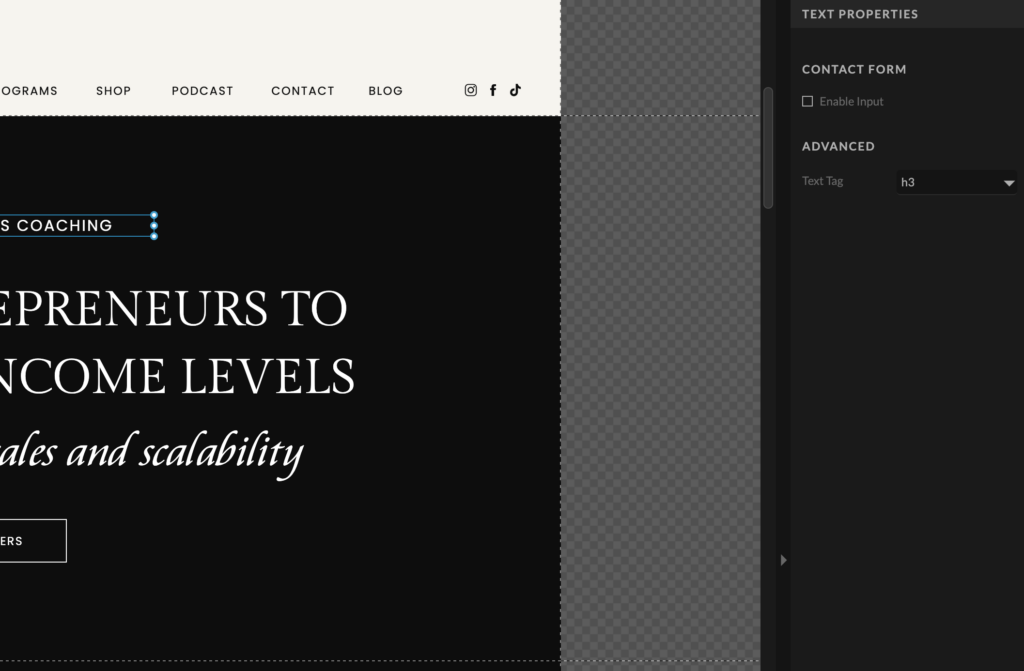Are you wondering, ‘Do I really need to worry about SEO?’ The answer is a resounding yes! Learn how to maximise your Showit website’s rankings and visibility with these easy, actionable steps.
Is Showit good for SEO?
Let’s get straight to it. You have a beautifully designed Showit website, but is it any good for managing your SEO? Absolutely.
Showit is user-friendly and allows you to tailor each page on your website with built-in SEO settings. These are easy to edit, and with some basic SEO knowledge (don’t worry, I’ll explain more), can help improve your website’s ranking.
Beyond its seamless integration with blogging powerhouse WordPress, Showit is a significant ally in a successful SEO strategy.
What I also want to mention is that even though this post talks about Showit, no website platform is inherently bad for SEO. Some may have more user-friendly features than others but ultimately, it comes down to your content followed by your optimisation of the overall website and individual pages.
No platform will magically make your website appear on the number 1 search results, your content has to do that. (which is why I always recommend my clients to start a blog, blogging is amazing for SEO!)
Now, onto the tips that will ensure you have the most optimised start to your SEO journey with Showit.
Does Showit have built-in features supporting SEO?
Yes! Technical features already taken care of that will enhance your website SEO performance include:
- SSL Certificates – Showit automatically creates an SSL certificate for your site, adding a valued layer of security which search engines (and visitors) love.
- Mobile-Friendly – Luckily, Showit website designs are optimised for users to view on the go, which Google prioritises for ranking.
- Fast Page Loading – Another Google preference that enhances SEO performance.
- Sitemap – Showit creates a sitemap by default, which Google uses to crawl your website.
How can you improve SEO on your Showit website?
Every page on your website needs to be tailored so search engines deem it worthy of a nice high ranking. This means more visibility for your brand and click-throughs from potential customers. So, how do you optimise a webpage for SEO?
Let’s start at the beginning…
Consider heading text properties on Showit
Your page headings are the essential foundations for pulling your page together in a cohesive way. They should guide the reader through the page, creating interest and intrigue.
Label and structure headings logically so that the content and intent of the page are clear to search engines, improving your chances of a higher ranking for relevant searches.
In your SEO settings, assign the following heading properties:
- H1 – This is the main title of your page, and there should only ever be one per page.
- H2 – Label section headings of your content as H2.
- H3 – If you need sub-headings to break down H2 content, label them H3. And so on…

Optimised headings maximise SEO potential, so always include your main keyword in your H1, use questions as headings (they tend to rank higher), and make them informative. Resulting in happy users and search engines – and that’s the aim of the game!
Next up…
Use page titles and meta descriptions for enhanced SEO
The page title and meta description are the snippets of information that appear on search engine results pages (SERPs). As the first impression to a user, give them context and clarity to encourage the all-important ‘click’.
Page Title Tag:
- 50-60 characters approx.
- A very brief description of what the page is about and to include the main keyword.
Meta Description:
- 150-160 characters approx.
- A slightly longer description of your page content. Create intrigue, and don’t give too much away – you want the reader keen to learn more. Always end with a call to action (CTA), making a ‘click’ their next logical step.
The character counts are purely a guide. I would say it’s more important to concentrate on making your title and description captivating and engaging the reader to want to learn more.
Take a look here for a step-by-step guide on How to add meta descriptions in Showit.
Optimising images for SEO on Showit
Images bring a page to life (I mean, have you seen the beautiful images on our Showit templates?) Still, they must also be optimised to impact your SEO positively. So, what should you do once you’ve chosen your ideal images?
- Image size and format – Ensure the image is the correct size and format for your Showit design; Resize if needed, and upload as a JPEG for standard images to improve load time.
- Image file name – Save your image with a name applicable to the picture, and include keywords where you can. It helps search engines clarify that your image applies to your text when ranking.
- Image alt text – Search engines and screen readers use alt text to give context to an image. Each image should be given a brief but specific and unique alt text in your Showit design settings. Include keywords to maximise SEO.
Use SEO-friendly plug-ins for WordPress on Showit
If you’re using WordPress on your Showit website, you’ll already know that regularly posting SEO-rich blog posts is paramount for climbing search engine rankings.
SEO plug-in tools such as Yoast SEO and Rank Math are simple to use, with SEO analysis and improvement suggestions for keywords, readability, headings, alt text and linking.
Structuring your blog posts using these tools, alongside including strong keywords, will ensure they are optimised for SEO, drawing valuable visitors to your site.
Once you’ve implemented these strategic SEO fundamentals, the next step is to ensure you’re getting results! Let’s delve into exactly how you can do that.
What are easy ways to track your Showit website SEO?
It’s vital to establish that the simple SEO fundamentals you’ve implemented are achieving results. Consider these beginner-friendly SEO tools to check you’re on the right path:
- Google Analytics – Ideal for tracking user behaviour on your site, such as traffic from search engines, page engagement and conversions.
- Google Search Console – Use for website performance-based analytics. According to Google, ‘Search console tools and reports help you measure your site’s search traffic and performance, fix issues and make your site shine in Google search results’.
- Ubersuggest – A simple tool that can produce a website audit report analysing your website’s SEO performance –including keyword performance, page load time, etc.
These are brilliant tools to track your website’s SEO performance, see what’s working well, and identify any areas for improvement.
Are you serious about your Showit website’s success? Take the time to get SEO savvy
I promise it’s not as scary as it looks. A proactive approach to assessing and refining your website for SEO will result in a powerful free marketing tool. Because that’s precisely what it is.
Implementing the simple strategies we’ve discussed to improve your Showit website’s SEO leaves you free to concentrate on other areas of your entrepreneurial game plan. At the same time, your website works away hard in the background for you!
Curious to learn more about how a Showit website can work as hard as you do? Let’s chat! Book a 1:1 strategy call with me here.
